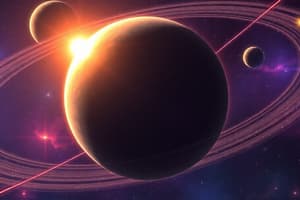Podcast
Questions and Answers
A continuación, se presentan características del Sol y los planetas. Empear los pares adecuados:
A continuación, se presentan características del Sol y los planetas. Empear los pares adecuados:
Diametro de 1.4 millones de kilómetros = Característica del Sol Compuesto principalmente de hidrógeno y helio = Composición del Sol Tiene un impacto significativo en el clima de la Tierra = Efecto del Sol en la Tierra Orbitan alrededor del Sol = Característica de los planetas
A continuación, se presentan procesos que ocurren en el Sol y los planetas. Empear los pares adecuados:
A continuación, se presentan procesos que ocurren en el Sol y los planetas. Empear los pares adecuados:
Fusión nuclear = Proceso que produce energía en el Sol Orbita alrededor del Sol = Movimiento de los planetas Combina hidrógeno para formar helio = Reacción química en el Sol Mantiene unidos a los planetas y objetos celestes = Efecto de la gravedad del Sol
Se presentan a continuación características de los objetos celestes en el sistema solar. Empear los pares adecuados:
Se presentan a continuación características de los objetos celestes en el sistema solar. Empear los pares adecuados:
Es el centro del sistema solar = Característica del Sol Son ocho en total = Cantidad de planetas Incluye asteroides y cometas = Tipos de objetos celestes Es la fuente de luz y calor = Función del Sol
A continuación, se presentan características de los planetas en el sistema solar. Empear los pares adecuados:
A continuación, se presentan características de los planetas en el sistema solar. Empear los pares adecuados:
Se presentan a continuación procesos que ocurren en el sistema solar. Empear los pares adecuados:
Se presentan a continuación procesos que ocurren en el sistema solar. Empear los pares adecuados:
A continuación, se presentan características del Sol y su influencia en el sistema solar. Empear los pares adecuados:
A continuación, se presentan características del Sol y su influencia en el sistema solar. Empear los pares adecuados:
Relaciona cada planeta con una de sus características principales:
Relaciona cada planeta con una de sus características principales:
Vincula cada planeta con su posición en el sistema solar:
Vincula cada planeta con su posición en el sistema solar:
Asocia cada planeta con su tamaño comparado con la Tierra:
Asocia cada planeta con su tamaño comparado con la Tierra:
Relaciona cada planeta con una característica particular:
Relaciona cada planeta con una característica particular:
Vincula cada planeta con un aspecto climático distintivo:
Vincula cada planeta con un aspecto climático distintivo:
Asocia cada planeta con su descripción estelar:
Asocia cada planeta con su descripción estelar:
Flashcards are hidden until you start studying
Study Notes
Solar System: Understanding Planets and the Sun
The solar system is a vast and complex celestial body consisting of the sun, planets, and other celestial objects. The sun, a massive ball of hot gas, is the center of our solar system and is responsible for the existence of life on Earth. In this article, we will discuss the planets and the sun in detail, providing a comprehensive understanding of our solar system.
The Sun
The sun is the largest object in the solar system, with a diameter of about 1.4 million kilometers. It is a massive, shining ball of gas, primarily composed of hydrogen and helium, and it is the source of all the light and heat that sustains life on Earth. The sun's energy is produced through a process called nuclear fusion, where hydrogen atoms combine to form helium, releasing enormous amounts of energy.
The sun's gravity holds the solar system together, keeping planets, dwarf planets, asteroids, and comets from drifting into space. Its position at the center of the solar system is crucial, as it provides the necessary conditions for life to exist. The sun also has a significant impact on the Earth's climate, affecting the Earth's surface temperature and influencing weather patterns.
Planets
The solar system consists of eight planets, each with unique characteristics and orbits around the sun. These planets are:
-
Mercury: The smallest and closest planet to the sun, Mercury is a rocky, cratered planet with a surface temperature that can reach up to 1,000°C (1,832°F).
-
Venus: Similar in size to Earth, Venus is the second planet from the sun and is characterized by its thick, toxic atmosphere and surface temperatures that can reach up to 464°C (867°F).
-
Earth: Our home planet, Earth is the third planet from the sun and is the only known planet to support life. It is characterized by its diverse ecosystems, oceans, and an atmosphere that supports the existence of life.
-
Mars: Known as the red planet, Mars is the fourth planet from the sun and is similar in size to Earth. It has a thin atmosphere and a cold, dry climate.
-
Jupiter: The largest planet in the solar system, Jupiter is the fifth planet from the sun and is a gas giant with a massive atmosphere and numerous moons.
-
Saturn: Known for its prominent ring system, Saturn is the sixth planet from the sun and is another gas giant, with a complex system of rings and moons.
-
Uranus: The seventh planet from the sun, Uranus is an ice giant with a tilted axis, which results in extreme seasons.
-
Neptune: The eighth and farthest known planet from the sun, Neptune is also an ice giant with a deep blue color and a strong, cold wind.
Conclusion
The solar system is an intricate and fascinating celestial body, with the sun at its center and a diverse array of planets orbiting around it. Understanding the planets and the sun is crucial for comprehending the conditions that sustain life on Earth and for exploring the vastness of space. As we continue to explore and learn more about our solar system, we gain a better understanding of our place in the universe.
Studying That Suits You
Use AI to generate personalized quizzes and flashcards to suit your learning preferences.




